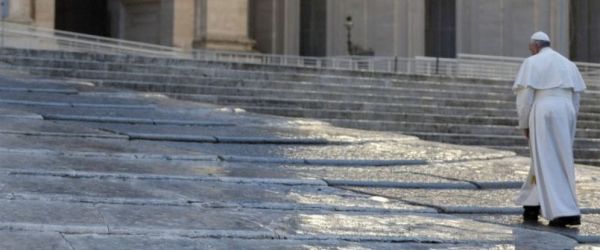On this Fifth Sunday of Lent, the liturgy presents us the episode of the adulterous woman (cf. Jn 8:1-11). In it, there are two contrasting attitudes: that of the scribes and the Pharisees on the one hand, and that of Jesus on the other. The former want to condemn the woman because they feel they are the guardians of the Law and of its faithful implementation. Jesus, on the other hand, wants to save her because he personifies God’s mercy which redeems by forgiving and renews by reconciling.
Let us thus look at the event. While Jesus is teaching in the Temple, the scribes and the Pharisees bring him a woman who has been caught in adultery. They place her in the middle and ask Jesus if they should stone her as the Law of Moses prescribes. The Evangelist explains that they asked the question in order “to test him, that they might have some charge to bring against him” (v. 6). One might think that this was their purpose: behold the iniquity of these people — a ‘no’ to the stoning would have been a pretext to accuse Jesus of disobeying the Law; a ‘yes’ instead, to report him to the Roman Authority which had reserved such sentences to itself and did not permit lynching by the people. And Jesus must respond.
Jesus’ interrogators are confined to narrow legalism and want to oblige the Son of God to conform to their perspective of judgment and condemnation. However, he did not come into the world to judge and condemn, but rather to save and offer people a new life. And how does Jesus react to this test? First of all, he remains silent for some time and then he bends down to write on the ground with his finger, almost as if to remind them that the only Legislator and Judge is God who had inscribed the Law on stone. And then he says: “Let him who is without sin among you be the first to throw a stone at her” (v. 7). In this way, Jesus appeals to the conscience of those men: they felt they were the ‘champions of justice’, but he reminds them of their own condition as sinners, due to which they cannot claim the right to life or death over one of their fellow human beings. At that point, one after the other, beginning with the eldest — that is, those who were more fully aware of their own failings — they all went away, and desisted from stoning the woman. This episode also invites each of us to be aware that we are sinners, and to let fall from our hands the stones of denigration, of condemnation, of gossip, which at times we would like to cast at others. When we speak ill of others, we are throwing stones, we are like these people.
And in the end only Jesus and the woman are left there in the middle: “misery with mercy”, as Saint Augustine says (In Joh 33:5). Jesus is the only one without fault, the only one who could throw a stone at her, but he does not do so, because God “does not want the death of the wicked but that the wicked convert and live” (cf. Ez 33:11). And Jesus sends the woman on her way with these wonderful words: “Go and do not sin again” (Jn 8:11). And thus Jesus opens a new path to her, created by mercy, a path that requires her commitment not to sin again. It is an invitation that applies to each one of us. When Jesus forgives us, he always opens a new path on which to go forward. In this Lenten Season, we are called to recognize ourselves as sinners and to ask God for forgiveness. And, in its turn, while forgiveness reconciles us and gives us peace, it lets us start again, renewed. Every true conversion is oriented toward a new future, a new life, a beautiful life, a life free from sin, a generous life. Let us not be afraid to ask Jesus for forgiveness because he opens the door to this new life for us. May the Virgin Mary help us to bear witness to all of the merciful love of God, who through Jesus, forgives us and renders our lives new, by always offering us new possibilities.
[Pope Francis, Angelus 7 April 2019]












